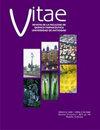木薯粉水解发酵制乳酸
Q3 Pharmacology, Toxicology and Pharmaceutics
引用次数: 1
摘要
背景:乳酸(LA)是一种羧酸,在食品工业中广泛用作防腐剂、酸化剂和调味剂;它也是生产乳酸酯、丙二醇、2,3-戊二酮、丙酸、丙烯酸和乙醛的原料。近年来,由于其作为聚乳酸合成的单体,在许多工业应用中用作塑料的可生物降解聚合物,对LA的生产需求急剧增加。LA可通过发酵或化学合成生产;由于环境问题和石油化工原料的有限性,前一条路线引起了相当大的兴趣;因此,全世界生产的90%的LA是通过发酵获得的,这一过程包括在微生物存在下将糖溶液(碳水化合物)生物转化为LA。目的:本工作旨在研究pH控制和培养基组成对利用农业工业部门的可再生资源生产LA的影响。方法:利用一株短乳杆菌菌株在好氧和厌氧条件下进行实验室规模的实验,使用三种不同的培养基组成:高营养含量培养基(MRS)作为对照,以葡萄糖为唯一碳源的低营养含量培养基(GM)和以木薯粉为碳源的潜在低营养含量培养基(HY1)。结果:厌氧条件下,MRS、GM和HY1培养基的LA产率分别为17.6±0.1、12.6±0.2和13.6±0.2 g LA/L。采用HY1培养基,研究了pH对5L生物反应器中LA生物合成的影响。在pH为6.5的条件下,发酵120 h,最高LA浓度为24.3±0.7g LA/L,产率为0.20 g/L/h, YP/S为0.32g LA/g糖浆。结论:这些结果与使用昂贵的碳源(如葡萄糖)的结果相当,表明木薯粉是一种有前途的低成本底物来源,可用于实验室和最终的大规模LA生物合成。本文章由计算机程序翻译,如有差异,请以英文原文为准。
LACTIC ACID PRODUCTION VIA CASSAVA-FLOUR- HYDROLYSATE FERMENTATION
Background: Lactic acid (LA) is a carboxylic acid widely used as preservative, acidulant, and/or flavouring in food industry; it is also used as a raw material for the production of lactate ester, propylene glycol, 2,3-pentanedione, propanoic acid, acrylic acid and acetaldehyde. In recent years, the demand for LA production has dramatically increased due to its application as a monomer for poly-lactic acid synthesis, a biodegradable polymer used as a plastic in many industrial applications. LA can be produced either by fermentation or chemical synthesis; the former route has received considerable interest, due to environmental concerns and the limited nature of petrochemical feedstocks; thus, 90% of LA produced worldwide is obtained by fermentation, this process comprises the bioconversion of a sugar solution (carbohydrates) into LA in the presence of a microorganism. Objectives: This work is aimed at studying the effect of pH control and culture media composition on the LA production using renewable sources from the agroindustry sector. Methods: A Lactobacillus brevis strain is used to perform lab scale experiments under aerobic and anaerobic conditions, using three different culture media compositions: a high nutritional content medium (MRS), as a reference, a low nutritional content medium with glucose as the only carbon source (GM), and a potential low nutritional content medium with cassava flour as carbon source (HY1). Results: The higher LA production is accomplished under anaerobic conditions, 17.6 ± 0.1, 12.6 ± 0.2 y 13.6 ± 0.2 g LA/L, for MRS, GM and HY1 medium, respectively. The effect of pH on LA biosynthesis in a 5L bioreactor is also studied using the HY1 medium. For a fermentation time of 120 h, the highest LA concentration obtained was 24.3 ± 0.7g LA/L, productivity 0.20 g/L/h, YP/S 0.32g LA/g syrup, at pH 6.5. Conclusions: These results are comparable with those using expensive carbon sources such as glucose, and show cassava flour as a promising low-cost substrate source for lab and eventually large scale LA biosynthesis.
求助全文
通过发布文献求助,成功后即可免费获取论文全文。
去求助
来源期刊

Vitae
PHARMACOLOGY & PHARMACY-
CiteScore
1.20
自引率
0.00%
发文量
0
审稿时长
>12 weeks
期刊介绍:
The journal VITAE is the four-monthly official publication of the School of Pharmaceutical and Food Sciences, and its mission is the diffusion of the scientific and investigative knowledge in the various fields of pharmaceutical and food research, and their related industries. The Journal VITAE is an open-access journal that publishes original and unpublished manuscripts, which are selected by the Editorial Board and then peer-reviewed. The editorial pages express the opinion of the Faculty regarding the various topics of interest. The judgments, opinions, and points of view expressed in the published articles are the responsibility of their authors.
 求助内容:
求助内容: 应助结果提醒方式:
应助结果提醒方式:


